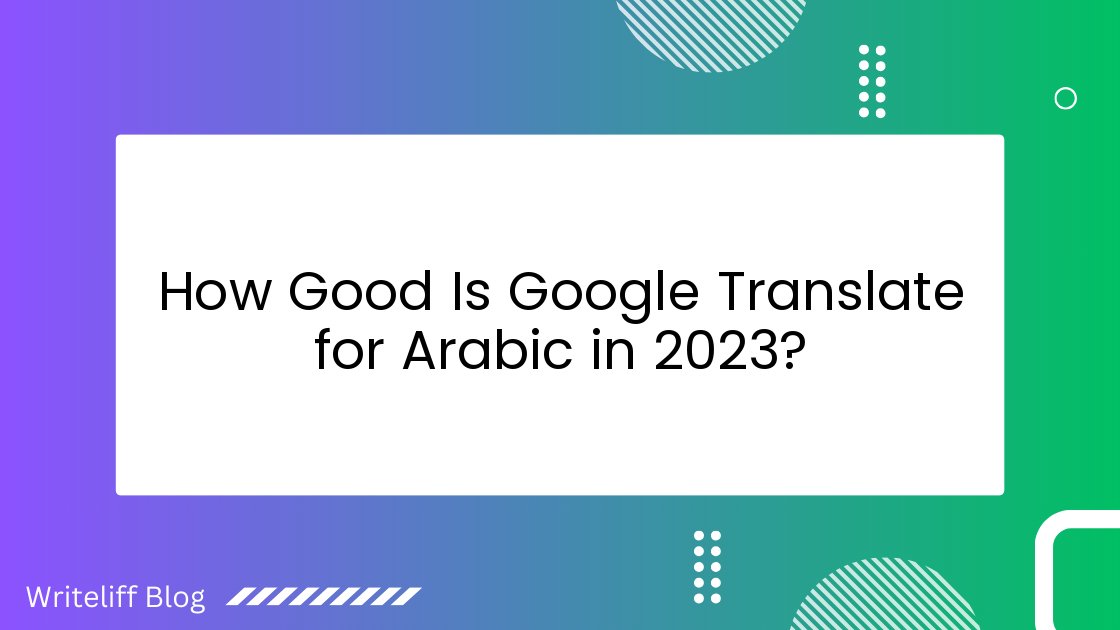How Good Is Google Translate for Arabic in 2023?

If you need to translate something quickly and don’t have a real-life translator handy, Google Translate can be a helpful tool. It’s especially useful for things like online shopping or reading news in other languages.
While human Arabic translation is still unbeatable, Google Translate has proven to be quite accurate, with a reported accuracy rate of about 85% in a survey conducted by Google.
For short translations, the results are usually consistent, but if you try to translate a whole page, things can get a bit wonky. While the text itself may be correct, the sentences and overall meaning may not always be perfect.
In this blog post, I’m going to take you through the reliability of Google Translate when it comes to translating Arabic and weigh up its pros and cons.
1. What Is Google Translate and How Does It Work?
Those who are familiar with the Internet and its capabilities are familiar with Google Translate. Google Translate is a free service provided by the search engine giant. In 2006, Google launched this machine translation service. Since then, it has been growing.
To use it, simply type a phrase or word into the text field. Select the language that you’ll be translating. Also, decide which language you’ll be translating it into. Isn’t it simple?
To get linguistic data, Google first looked at documents from the United Nations and the European Parliament. Now it’s time to improve translation accuracy. AI and machine learning were used to improve the software.
In 2016, Google pushed its translation services one step further. By switching to Neural Machine Translation, you’ll be able to save time and money (NMT). It is a method of deep learning. This entails utilizing a wide range of language resources.
2. What Are the Advantages of Using Google Translate?
Google has employed machine learning since its inception in 2006. Artificial intelligence is also being used to improve translations. Machine learning and artificial intelligence have gone a long way. These machines can now converse and comprehend in the same way as humans can.
They can understand natural language and respond to questions in a natural tone. The best translation tool available is Google Translate.
Furthermore, Google Translate has a number of outstanding features, including:
- Translating various sorts of language and speech.
- Translating handwriting and moving text within photographs.
- Supporting 109 languages at varying levels.
- Compatible with PCs, iPhones, and Android phones.
4. What Are the Major Drawbacks of Google Translate?
If you wish to utilize Google Translate, don’t be surprised if it goes rogue. Because its translations are dependent on statistical occurrences, it frequently makes mistakes. When working with sensitive data, creative works, or business-related content, however, use caution. It should not be your primary source of information. Moreover;
- Because there is no way to add context to Google Translate, the content may lose its significance during translation.’
- The translation quality is determined by the language pair. For languages like Spanish or English, Google’s popular translations are more accurate. Translations for languages not readily available in Google’s database, on the other hand, are less likely to be correct.
- Google Translate frequently produces translations that are riddled with grammatical problems. Grammatical rules are not taken into account by Google’s translation algorithm.
- There is no infrastructure in place for Google Translate to fix translation errors. There isn’t a way to report errors. There’s also no way to double-check what’s been translated.
- While Google Translate is free and simple to use, it is also too constrained due to the way its algorithm works.
Conclusion
As you can see, the pros and cons of using Google are crystal evident.
Google Translate may not be able to completely replace human translators at this time. However, because it is constantly improving, it will soon pose a serious challenge to human translation.
If you don’t have any other options and you need to translate something. Then use Google Translate to help you out. It is unlikely to have a significant impact on your life or business. If you’re using Google Translate, make sure you have a native Arabic speaker to proofread and review the translation.
Google Translate has unquestionably impacted the way we think about language. With their offline translation tool, making contact has never been easier or more affordable.
Even still, nothing beats having a real person do the translation. We’ll simply have to wait and see what the future has in store for us!
For this purpose, professional translation services are still the best alternative. To overcome the language barrier, human translators rather than artificial intelligence are used.
